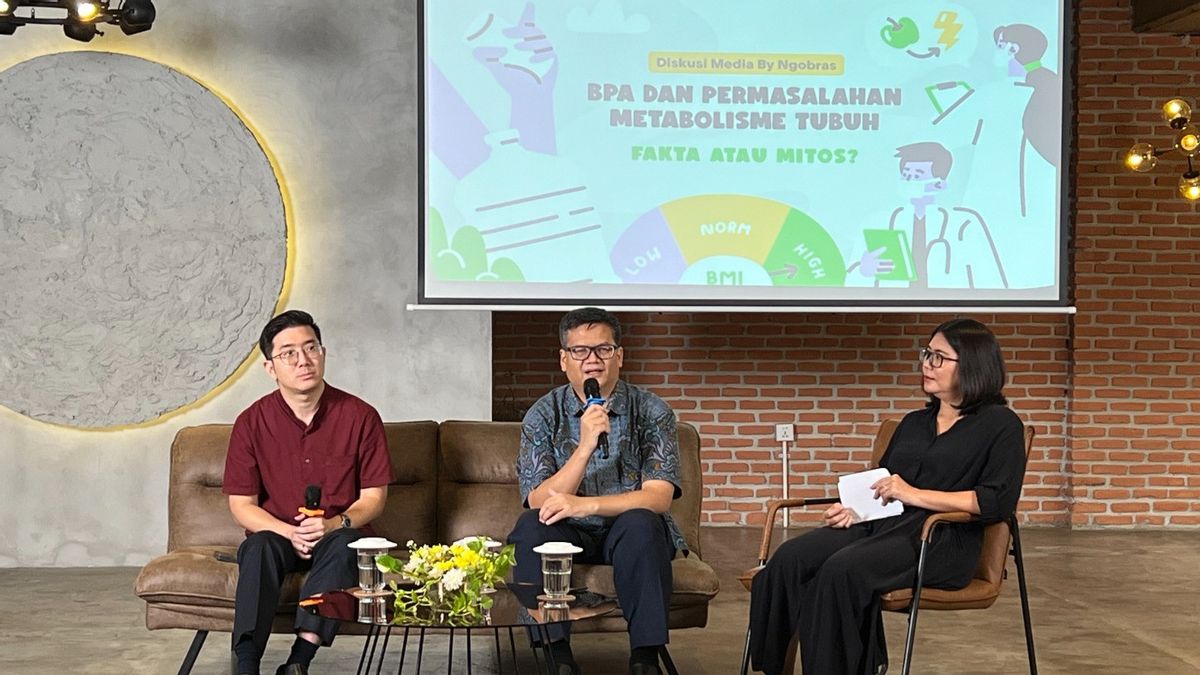JAKARTA - In April 2024, the Food and Drug Supervisory Agency (BPOM) recently issued the latest regulation, BPOM Regulation No. 6 of 2024 concerning processed food labels. This regulation adds two articles from the previous BPOM regulation No. 31 of 2018, specifically for bottled drinking water (AMDK). One of them is regarding the obligation to include labels on drinking water in polycarbonate plastic-based packaging that reads under certain conditions, polycarbonate packaging can release BPA on bottled drinking water'.
More socialization and education are needed to avoid potential polemics that may arise due to misunderstandings and confusing perceptions of this additional article. Prof. Dr. Nugraha Edhi Suyatma, STA, DEA, Professor of Engineering of the IPB Food Packaging Process, in a Joint Expert Discussion Forum for Health Journalists: The NGOBRAS Forum in Jakarta, Tuesday 10 September said, the most important thing is that the public needs to understand properly what conditions can make BPA overflow from packaging and enter drinking water.
"Usually, the migration or melting of the BPA from packaging to drinking water in a gallon only occurs under certain conditions, for example, if heated at a temperature of more than 250 degrees Celsius," he explained.
Nugraha added, in the production process of AMDK, no heating process occurred. It is only possible to be exposed to the sun in the distribution process, even then with temperatures below 50 degrees Celsius. Therefore, the risk of BPA migration to drinking water from its packaging will be very small.
"People don't need to worry about the risk of exposure to BPA on gallons of packaging made from polycarbonates. If you have obtained a BPOM distribution permit, it is a guarantee that the product is safe for consumption," he said.
Supporting Nugraha's statement, the Polymer Study Group driven by researchers and polymer experts from the Bandung Institute of Technology (ITB) has released the results of independent research on safety tests and quality of drinking water on gallon packaging made from polycarbonates from various well-known brands in West Java Province. The research results show that all bottled gallons of drinking water tested are proven not to contain BPA and are in accordance with the standards and regulations set by the government as well as international standards, so it is safe for public consumption.
Not only in Indonesia, drinking water brands in other countries such as Saudi Arabia, Qatar, Oman, United States, and Japan still use polycarbonate packaging. Even the US Environmental Protection Agency (EPA), an independent body of the United States government tasked with environmental protection affairs, set a safe limit for BPA exposure to humans to be 50 micrograms per body weight per day
Drinking water in plastic polycarbonates is often accused of containing the lurusan BPA and triggers various diseases such as hormonal disorders, autism in children, infertility, and cancer. However, this accusation was denied by a number of health experts who stated that until now there has been no scientific study proving that BPA or bottled drinking water made from polycarbonate plastic materials can cause human health problems.
Dr. dr. Laurentius Aswin Pramono, M.Epid, SpPD-KEMD, Internal Medicine Specialist with endocrinological, Metabolism, and Diabetes subspecialists, emphasized that the public needs to be guided by the scientific evidence of research on the exposure of BPA to humans.
"Until now, BPA has not been scientifically proven to pose a risk of disease. Research on exposure to BPA, which is currently an issue in the community, is still limited to research on experimental animals, not humans. Of course, research on experimental animals is different from the amount of exposure to BPA, which we accidentally consume every day," he explained.
The safe limit for BPA exposure is 4 mg/kg of weight per day. Meanwhile, studies show that in bottled water, the exposure of BPA is 0.01 mg/kg or 1 per 10,000. This means that it is necessary to consume 10 thousand liters of bottled drinking water in one drink to interfere with our body's function.
SEE ALSO:
"So it can be said that the risk of exposure is very small with the amount of our normal consumption. In addition, the human body itself has the ability to digest inorganic materials that are accidentally swallowed in small quantities such as BPA, through urine or feces," he added.
dr. Aswin added that drinking water packaged in gallons of polycarbonates is a product that has been consumed across the ages for years. There is no strong evidence so far that there is a risk to public health. The public does not need to worry about anything because it is affected by issues that are not clear, while health risk factors that have clearly been proven such as smoking habits, lack of exercise, poor diet, and consuming alcohol have been ignored.
With the facts that have been revealed above, it is hoped that the public will have a more qualified understanding of the safety of drinking water in a gallon of polycarbonate and there is no need to worry about the BPOM regulations regarding the inclusion of labels on bottled drinking water made from polycarbonate plastic. Until now, no scientific research has proven that BPA or bottled drinking water made from polycarbonate plastics has caused health problems that are harmful to human health.
In contrast, several studies have shown that the amount of lurusan BPA from gallons of polycarbonates is very small and insufficient to pose health risks.
The English, Chinese, Japanese, Arabic, and French versions are automatically generated by the AI. So there may still be inaccuracies in translating, please always see Indonesian as our main language. (system supported by DigitalSiber.id)











